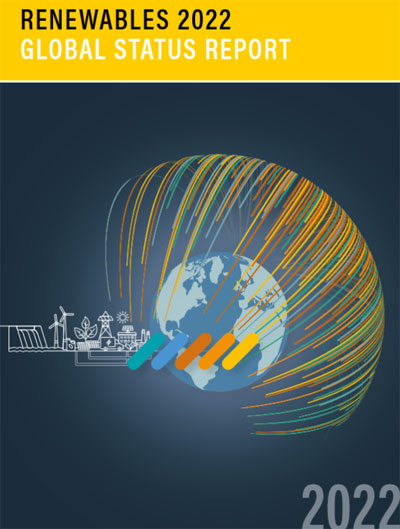Record growth in renewables, but world missed historic chance fora clean energy recovery, says latest REN21 report
- The share of renewables in global energy use stagnated in 2021, despite record additions to renewable power capacity.
- Rising energy consumption and a hike in fossil fuel use outpaced growth in renewables.
- The Ukraine war exacerbated a global energy crisis, creating windfall profits for fossil fuel companies while billions of people face the threat of energy poverty.

Despite the promise of a worldwide green recovery in the wake of the COVID-19 pandemic, this historic opportunity has been lost. REN21’s Renewables 2022 Global Status Report (GSR 2022) sends a clear warning that the global clean energy transition is not happening, making it
unlikely that the world will be able to meet critical climate goals this decade. The second half of 2021 saw the beginning of the biggest energy crisis in modern history, exacerbated by the Russian Federation’s invasion of Ukraine in early 2022 and unprecedented global commodity shock.
“Although many more governments committed to net zero greenhouse gas emissions in 2021, the reality is that, in response to the energy crisis, most countries have gone back to seeking out new sources of fossil fuels and to burning even more coal, oil and natural gas,” said Rana Adib, REN21 Executive Director.
The GSR annually takes stock of renewable energy deployment worldwide. The 2022 report is the
17th consecutive edition and provides proof of what experts have been warning about: the overall
share of renewables in the world’s final energy consumption has stagnated – rising only minimally
from 8.7% in 2009 to 11.7% in 2019 – and the global shift of the energy system to renewables is not
happening.
In the electricity sector, record additions in renewable power capacity (314.5 gigawatts, up 17% from
2020) and generation (7,793 terawatt-hours) were unable to meet the overall increase in electricity
consumption of 6%. In heating and cooling, the renewable share in final energy consumption
increased from 8.9% in 2009 to 11.2% in 2019. In the transport sector, where the renewable share
went from 2.4% in 2009 to 3.7% in 2019, the lack of progress is particularly worrying, as the sector
accounts for nearly a third of global energy consumption.
For the first time, the GSR 2022 provides a world map of renewable energy shares by country and
highlights progress in some of the leading countries.
Despite many new commitments to net zero, political momentum has not translated into action.

In the lead-up to the United Nations Climate Change Conference (COP26) in November 2021, a record 135 countries pledged to achieve net zero greenhouse gas emissions by 2050. However, only
84 of these countries had economy-wide targets for renewable energy, and only 36 had targets for
100% renewables. For the first time in the history of UN climate summits, the COP26 declaration
mentioned the need to reduce coal use, but it failed to call for targeted reductions in either coal or
fossil fuels.
The GSR 2022 makes clear that meeting countries’ net zero pledges will require massive efforts, and
that the momentum associated with COVID-19 has passed untapped. Despite important green
recovery measures in many countries, the strong economic rebound in 2021 – with global real gross
domestic product (GDP) growing 5.9% – contributed to a 4% rise in final energy consumption,
offsetting the growth of renewables. In China alone, final energy consumption rose 36% between
2009 and 2019. Most of the increase in global energy use in 2021 was met by fossil fuels, resulting in
the largest surge in carbon dioxide emissions in history, up more than 2 billion tonnes worldwide.
The collapse of the old energy order threatens the global economy.

The year 2021 also marked the end of the era of cheap fossil fuels, with the largest spike in energy
prices since the 1973 oil crisis. By the end of the year, gas prices reached around ten times the 2020
levels in Europe and Asia and tripled in the US, leading to a spike in wholesale electricity prices in
major markets by the end of 2021. The Russian’s Federation’s invasion of Ukraine deeply aggravated
the unfolding energy crisis, causing an unprecedented commodity shockwave that weighed heavily
on global economic growth, rattling the more than 136 countries that are reliant on fossil fuel
imports.
“The old energy regime is collapsing before our eyes – and with it, the global economy,” said Adib.
“Yet crisis response and climate goals must not be in conflict. Renewables are the most affordable
and best solution to tackle energy price fluctuations. We must boost the share of renewables and
make them a priority of economic and industrial policy. We can’t fight a fire with more fire.”
Renewables offer the chance for greater justice and energy autonomy.
Russian threats to halt critical exports of natural gas and oil, particularly to Europe, have underscored
the urgency of transitioning to renewables. To address the crisis, the European Union and national
and local governments have updated clean energy targets and pushed numerous measures to
accelerate the energy transition, yet they also continue to resort to old recipes. Although some
countries, such as the United Kingdom, have announced new taxes on energy majors, most countries
have simultaneously enacted new subsidies on fossil fuels. The coal, oil and natural gas industries
have been the main beneficiary of the energy crisis and governments’ responses, gaining both profits
and influence.
The GSR 2022 documents that despite renewed commitments to climate action, governments still
opted to provide subsidies for fossil fuel production and use as their first choice to mitigate the
effects of the energy crisis. Between 2018 and 2020, governments spent a whopping USD 18 trillion – 7% of global GDP in 2020 – on fossil fuel subsidies, in some cases while reducing support to
renewables (as in India).
This trend reveals a worrying gap between ambition and action. It also ignores the many
opportunities and benefits from transitioning to a renewable-based economy and society, including
the ability to achieve more diversified and inclusive energy governance through localised energy
generation and value chains. Countries with higher shares of renewables in their total energy
consumption enjoy greater energy independence and security.
“Instead of putting renewables on the back burner and relying on fossil fuel subsidies to reduce
people’s energy bills, governments should directly finance the installation of renewable energy
technologies in vulnerable households. In the end, the renewable energy path will come out cheaper,
despite the upfront investment,” said Adib.

“We call for short- and long-term targets and plans to shift to renewable energy, coupled with clear
end-dates for fossil fuels,” said REN21 President, Arthouros Zervos. “The uptake of renewables must
be a key performance indicator across all economic sectors.”
“The energy transition is our lifeline,” said Spanish Vice President and Minister for the Ecological
Transition and Demographic Challenge, Ms Teresa Ribera. “It will enable innovative business models
and forms of organisation, transform value chains, redistribute economic power and shape
governance in new, more people-centered ways. With the right investments in technology,
renewables are the only energy sources offering every country in the world a chance for greater
energy autonomy and security.”







